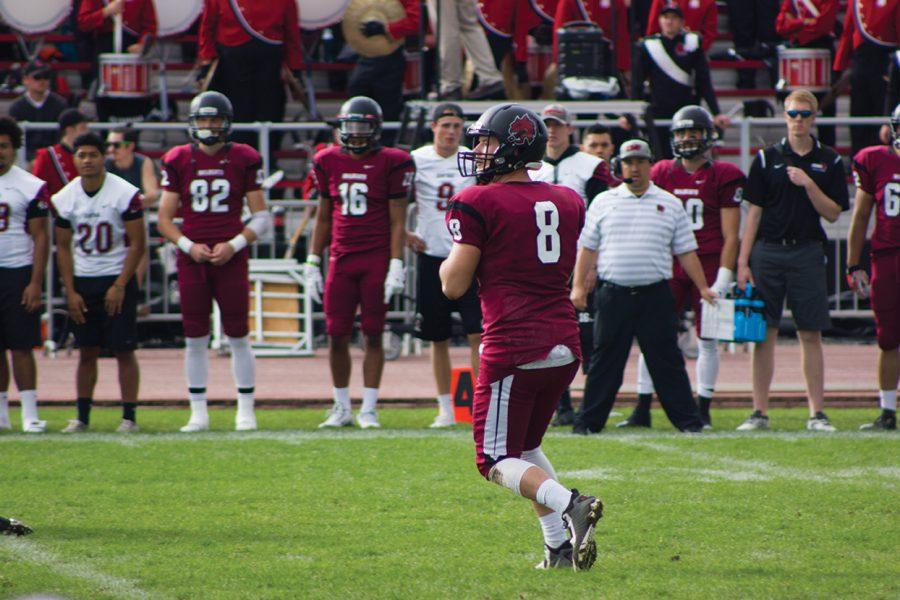Wildcats eye improvement on offense, defense
Quarterback Justin Lane returns for the Wildcats after claiming the starting job last season.
June 6, 2016
Change is a constant variable in everyone’s lives, for better or worse. After an offseason of changes for the Central Washington University football team, the Wildcats are looking to compete in the GNAC in 2016 and beyond.
CWU went 5-5 overall last season and 3-3 in GNAC play, putting it behind the pace set by conference winner, Humboldt State (10-2, 6-0 GNAC.)
One of the biggest storylines for the Wildcats last season was the midseason departure of incumbent starting quarterback Jake Nelson, after being moved into a co-starter role with Justin Lane.
Lane, who transferred from Illinois State University in 2013, is now the unquestioned starter for the Wildcats this season. This comes after having a 58 percent completion percentage, 2,001 passing yards, and 12 passing touchdowns to 10 interceptions in nine games played while leading the GNAC in total offensive yards per game (233.1.)
Overall, the offense was a major problem for the Wildcats, as they were second in the GNAC in interceptions thrown, fifth in rushing offense and allowed the most sacks. CWU hired a new offensive-line coach, Chris Fisk, to help bring the sack total down, but everything else comes down to execution by players throughout the game.
“There’s no such thing as a 10-point play or a 20-point play,” said wide receiver Jesse Zalk. “If you’re down in a game or just had a turnover, we have to just come back as strong as you can to try and make a play. We’re gonna have a sack, or a tackle for a loss, you just have to come back and not give up.”
Zalk believes every facet of the offense being on the same page is key for execution.
Special teams should continue to rank at the top of the conference with the presence of Zalk, who ranked first in the GNAC in total kick-return yards with 813. Zalk was also second in the conference in receptions and receiving yards per game, with 4.8 receptions per game and 75 receiving yards per game
After the departure of defensive coordinator Payam Saadat for California Polytechnic University, head coach Ian Shoemaker brought in Scott Power to run a new-look defense that hopes to fare better than last year.
Coach Power inherits a defense that gave up 376.2 yards and 31.1 points per game, good for third and fourth in the GNAC, respectively. CWU did not succeed at stopping the run, giving up 201.8 rushing yards per game (fourth in GNAC). However, the Wildcats’ pass defense was successful. They were second in both passing yards allowed per game (174.4) and interceptions (12) and first in passing completion percentage allowed (47.2).
Power served as the defensive coordinator at Marian University for three seasons, including winning the NAIA National Championship in 2015, running a 4-2 nickel defense that has proven successful in recent years against the passing and running games.
“I think we have talented players,” Power said. “We just need to establish a standard of play that is very high.”
Junior linebacker Kevin Haynes, CWU’s leading tackler the past two seasons, is excited to play in Power’s system and become a more disruptive defense.
“I thought we had a good spring,” Haynes said. “We were installing a whole new system, but I thought we picked it up fairly quickly. Coach [Power] is an extremely smart man. He knows football really well.”
Power and the defense are expected to have a major turnaround against the run as well as create more turnovers.
“If you look at any great defense in the history of football, they all have one thing in common,” Haynes said. “It’s stopping the run, which is a thing we didn’t do very well last year. The first thing Coach Power said to us this spring is that, ‘We will stop the run.’ I think our scheme alone will help us do that.”
The challenge for CWU starts immediately in week one of the season, when the team travels to Portland to take on Portland State University, a Division I FCS school. Haynes and Zalk, both from nearby Battle Ground, Washington, are excited to head to their home and show what the Wildcats have to offer this season.
“Any time you can play an opponent from a bigger school and see where you’re at is always a good time,” Haynes said.


